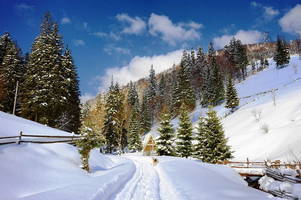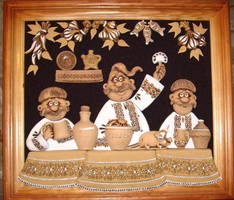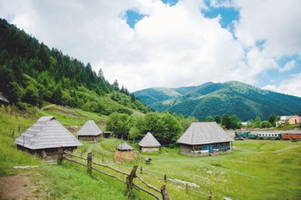THE UKRAINIAN CARPATHIANS
Experience the beauty and magic of the Carpathian Mountains. The crystal streams, majestic peaks and sweet smelling forests will enchant you. This region is not only famous for its natural beauty but for the cultural richness of its inhabitants. Visit the local mountain markets where master artisans sell their folk art treasures. See history unveil before your eyes as age-old customs, traditions and folk dress come to life before you. The Carpathian Mountains are an adventure you will not soon forget!
In Ukrainian Carpathians you can experience a lot of adventures including:
-exciting trip along the mountains on Carpathian tram on narrow-gauge railway built in 1898;
-hiking the highest peak of Ukrainian Carpathian mountains Hoverla (2061m);
-visit unique wooden churches and monasteries;
-Rafting;
-Horse riding;
-Cycling;
-Swim in the mountain rivers.
Geographic position. Ukrainian Carpathians are part of Eastern Carpathians and rise in the west of Ukraine within Lviv, Ivano-Frankivsk, Transcarpathian and Chernivtsi regions. Carpathians on the territory of Ukraine extend from north-west to south-east as a strip 270 km in length and 100-110 km in width. These are mid-height mountains, their average height is 1000 m. All the highest peaks – Hoverla (2061 m), Brebenescul (2032 m), Pop-Ivan (2032 m), Petros (2020 m), Hutyn-Tomnatyk (2016 m), Rebra (2010 m) are concentrated in the mountain mass of Chornogora. Hoverla is the highest mountain and the highest point on the territory of modern Ukraine. Hoverla is located on the border of Transcarpathian and Ivano-Frankivsk regions, about 17 km from the border with Romania. The name is of Hungarian origin and means “snowy mountain”. The first tourist route with climbing the mountain was opened in 1880. Today hundreds of tourists ascend the mountain every day. When visibility is good to the north you can see cities of Ivano-Frankivsk, Kolomiya and Snyatyn, and in southern direction – Roman city Sighetu-Marmatiei. At the foot of the mountain is one of the sources of river Prut. Not far from the place where water is out of the rocks, is a waterfall, height of which is about 80 m. Brebenescul is one of the highest peaks of the ridge Chornogora, is in the middle of the ridge on the border of Ivano-Frankivsk and Transcarpathian regions. Mount Pip Ivan is on the south-eastern end of the ridge. The mountain is famous mainly by the building of the former observatory “White elephant”, which stands at the top of the mountain. The name of the observatory was most likely due to the fact that every winter it accumulates much snow and ice, becoming to look like a large white beast from the distance. Mount Petros is located at the north-western end of the ridge Chornogora between mountains Sheshul and Hoverla in Rakhiv district of Transcarpathian region. The mountain is a tourist attraction with starting point at railway station Kvasy. Route length is 15 km. Hutyn-Tomnatyk is the peak of the western spur of Chornogora. Subalpine and alpine vegetation with a large number of rare and relict species grows on the mountain. Peak Rebra is located in the central part of the ridge. A number of rare plants listed in the Red Data Book of Ukraine, including cedar pine, Carpathian yellow herb, recumbent cliff-dweller, etc. are also growing there.
At an altitude of 1793 m above sea level on the south-western slope of Chornogora ridge, in the valley between the mountains Brebenescul and Hutyn-Tomnatyk is located the very high-altitude lake of Ukraine, Brebenescul.
There are about 28 thousand rivers in Carpathians. The largest rivers are Dnister and Tysa. Such rivers as Latoritsa, Teresva, Stryy, Prut, Siret, Uzh, White and Black Cheremosh were formed as a result of fractures in the earth. The rivers originate in the depths of the mountains, at high altitudes. Rapids and waterfalls are often found.
Climate. The climate of Carpathians is determined primarily by geographic location of the mountains, their significant height above sea level, form of relief. Depending on the altitude above sea level and sum of active temperatures, in Carpathians are defined six climatic zones: very warm, warm and moderately warm (in the plains and foothills), cool – in the middle mountains, moderately cold and cold – in the highlands. Carpathians belong to humid mountain regions. They are located on the routes of western and eastern air currents, which bring from Atlantic ocean, Mediterranean and Black seas significant amount of moisture.
Population. The territory of Ukrainian Carpathians is inhabited by representatives of about 76 different nationalities, who have created a unique cultural diversity of this region. Most of the population are Ukrainians. Carpathian Ukrainians are divided into three ethnographic groups: Boyky, who inhabit central part of Ukrainian Carpathians (south-western part of Rozhnyatyvskyy and Dolynskyy districts of Ivano-Frankivsk region, Skole, Turka, southern strip of Stryy, Drohobych, Sambir and most part of Staryy Sambir districts of Lviv region, northern part of Velykobereznyanskyy, Volovetskyy and Mizhgirskyy districts of Transcarpathian region), Lemky in the western part of Carpathians, on both slopes of the so-called Low Beskyds (part of Velykobereznyanskyy and Perechynskyy districts of Transcarpathian region), Hutsuls in eastern part of Ukrainian Carpathians (Verkhovynskyy, Kosiv, southern part of Nadvirna and Bohorodchany districts of Ivano-Frankivsk region, adjacent Putylskyy, southern part of Vyzhnytskyy and Starozhynetskyy districts of Chernivtsi region, Rakhiv district of Transcarpathian region). Hungarians, Russians, Romanians, Gypsies, Slovaks, Germans, Jews, Belarusians, Czechs, Poles, Italians, Armenians, Azerbaijanians and representatives of other nationalities also live in Carpathians.
Traditions and customs. Christmas is one of the most respected holidays in Ukrainian Carpathians. Celebration of Christmas starts on the eve of January 6 with family dinner. Housekeepers light “live fire” in the stove in the morning from twelve logs and prepare twelve ritual meatless dishes. The table is covered with hay and lay cloth, teeth of garlic are put on the corners of the table, to avoid the evil forces, and grains of wheat, to multiply children. When the first star appears, the eldest in the family brings to the house specially twisted sheaf of wheat, which is called Didukh. Then begins the prayer-saying – invitation of all souls to holy dinner and supplication about blessing of family and homestead. It is said by eldest in the family or a man. Then the family begins holy dinner. The most interesting is the Caroling (ceremonial round of houses and performing of carols – folk songs with religious content). After the sound of trembita, children and young people go to sing carols. Besides caroling is gathered the Nativity play, which shows Christmas drama. The girls, who sing carols, are called “korolytsya”, and boys – “lugovyky”.
One of the most joyous holidays is celebration of Resurrection of Christ – the biggest Christian holiday. On Palm Sunday, a week before Easter, people sanctify willow branches, which are called “byechky”, hit slightly each of their family, saying “I do not beat, byechka beats – from now in a week is Easter!”. Consecrated willow is hung at home, it is considered that it has healing properties.
On the eve of Easter all get ready for the holiday – keep the fast for 40 days, attend special liturgies on Great Lent and prepare Easter attributes. The oldest attribute of Easter is Easter egg, decorated with paintings and ornaments, - pre-Christian symbol of the Sun, life, immortality, rebirth, goodness, joy and happiness. In Christian tradition the Easter egg became the symbol of faith in the resurrection of Jesus Christ. Besides painted Easter eggs, inhabitants of Carpathians prepare Easter dishes that are sanctified on Sunday during morning liturgy. On Easter all day long church bells chime in the mountains, telling about great Christian good news.
National dishes. Ethnic diversity of Carpathians is reflected also in local cuisine. Beside the typical Ukrainian dishes as borsch, dumplings and cabbage rolls, the menu will definitely contain banosh (maize porridge with sheep cheese, cracklings or mushrooms). Every village has its own recipe of banosh, like borsch. Mushroom soup is also an indispensable dish of Carpathian national cuisine. Menu will also contain all sorts of fish dishes, mostly trout, caught in crystal clear mountain streams.








